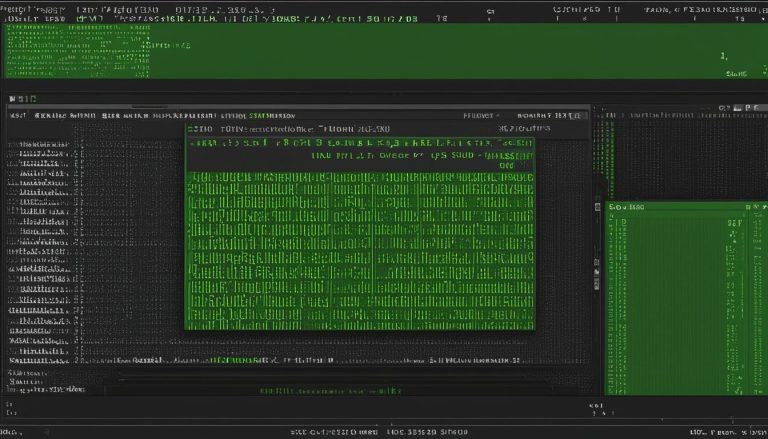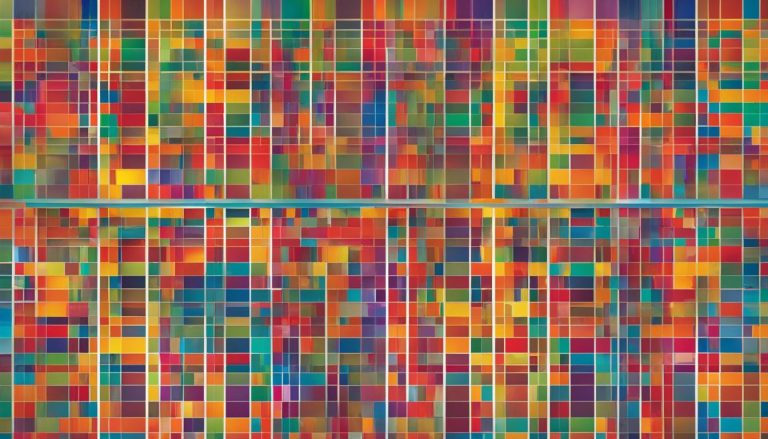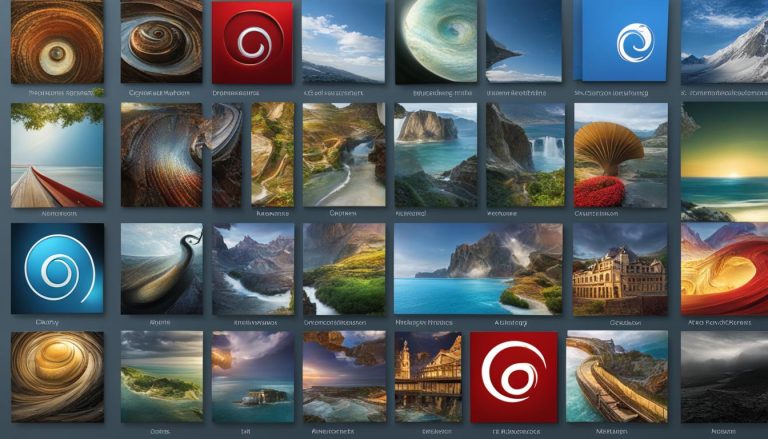KDE is a powerful and versatile desktop environment that offers a wide range of features and applications for users to enhance their computing experience. In this section, we will delve into the history, overview, and notable features of KDE, providing you with a comprehensive understanding of this popular desktop environment.
Key Takeaways:
- KDE is a free desktop environment and development platform built with Trolltech’s Qt toolkit.
- It runs on most Unix and Unix-like systems, as well as Mac OS X and Microsoft Windows.
- The “K” in KDE originally stood for “Kool” and later changed to simply stand for the letter “K”.
- KDE aims to provide an intuitive and user-friendly interface for interacting with computer systems.
- KDE offers a wide range of features and applications, including software development and office software tools.
Features of KDE
KDE offers a wide range of features and applications that enhance the computing experience for users. Whether you’re a software developer or need office software, KDE has you covered. One notable application is KDevelop, a powerful IDE for software development. With its intuitive interface and robust features, KDevelop makes coding a breeze. Another noteworthy application is KOffice, which provides a suite of office software including word processing, spreadsheets, and presentation tools. These applications are just a glimpse of what KDE has to offer.
What sets KDE apart is its emphasis on user-friendly graphical interfaces. KDE ensures that users can interact with their computer systems in an intuitive and logical manner. Clear and straightforward representations of actions and results, whether through icons or text, make navigating the desktop environment seamless. Additionally, KDE allows for customizable interfaces, allowing users to personalize their experience to suit their preferences. Themes, widgets, and desktop effects can all be customized to create a visually engaging and tailored desktop environment.
To provide further insights into the features and applications of KDE, let’s take a closer look at a comparison table:
| Feature | KDE | Other Desktop Environments |
|---|---|---|
| Software Development | KDevelop | Various IDEs |
| Office Software | KOffice | Various Office Suites |
| Graphical Interface | Intuitive and customizable | Varies |
| Customization Options | Themes, widgets, desktop effects | Varies |
As seen in the comparison table, KDE offers a unique combination of features and customization options that cater to the needs of different users. Its intuitive interface, extensive application ecosystem, and flexibility make it a preferred choice for many individuals looking for a user-friendly and customizable desktop environment.
History of KDE
KDE, short for K Desktop Environment, was founded in 1996 by Matthias Ettrich, a student at the University of Tübingen. Ettrich aimed to develop a desktop environment that offered consistent and user-friendly applications. The name KDE was a play on the existing Common Desktop Environment (CDE) available for Unix systems.
The initial version of KDE was built using Trolltech’s Qt framework, which provided the foundation for the desktop environment. Over the years, KDE has gone through various updates and versions, with the latest iteration being KDE Plasma. In 2009, the KDE project components were rebranded to highlight the community of software creators and the diverse range of tools provided by KDE.
Throughout its history, KDE has remained a popular choice for users seeking a customizable and feature-rich desktop environment. With its roots in the Unix-like operating systems, KDE has expanded its compatibility to include Mac OS X, Microsoft Windows, and other platforms through the use of X11 and Cygwin.
Key Milestones in KDE History
- 1996: Matthias Ettrich founds KDE and starts developing the desktop environment.
- 1998: Release of KDE 1.0, marking the first stable version of the desktop environment.
- 2002: Introduction of KDE 3, which brought significant enhancements and improvements.
- 2008: KDE 4 is released, introducing a modernized interface and advanced features.
- 2014: KDE Plasma 5 is launched, emphasizing usability, performance, and visual aesthetics.
With its rich history and continuous development, KDE has become a trusted choice for users seeking a powerful and user-friendly desktop environment. Its commitment to providing an intuitive interface and a wide range of applications has solidified its position as one of the leading desktop environments in the open-source community.
| Year | Milestone |
|---|---|
| 1996 | Matthias Ettrich founds KDE |
| 1998 | Release of KDE 1.0 |
| 2002 | Introduction of KDE 3 |
| 2008 | Release of KDE 4 |
| 2014 | Launch of KDE Plasma 5 |
Installing and Customizing KDE
KDE, being a versatile desktop environment, can be installed on various operating systems, including Linux, BSD, Solaris, Mac OS X, and Windows. The installation process may differ depending on the operating system, but there are resources and guides available to assist users in every step of the way. Whether you are a beginner or an advanced user, the installation procedure is designed to be user-friendly and accessible.
Once KDE is successfully installed, users can take advantage of its extensive customization options to tailor their desktop environment according to their preferences. KDE offers a plethora of themes, widgets, and desktop effects that allow users to personalize the appearance, layout, and functionality of their desktop. This level of customization ensures that each user can create a unique and personalized computing experience.
Customization Options
Here are some of the key customization options available in KDE:
- Themes: KDE provides a wide range of themes that can change the overall look and feel of the desktop. Users can choose from various themes, including dark themes for a more minimalist look or vibrant themes for a visually appealing experience.
- Widgets: KDE offers a collection of widgets that can be added to the desktop to provide quick access to information and frequently used applications. Users can customize the placement and appearance of these widgets to suit their workflow.
- Desktop Effects: KDE includes a variety of desktop effects that can enhance the visual experience. Whether it’s a smooth transition when switching between virtual desktops or stunning visual effects, users have the ability to customize and enable these effects according to their preferences.
With the flexibility and customization options provided by KDE, users can truly make their desktop environment their own. Whether you prefer a sleek and minimalistic design or a vibrant and visually engaging interface, KDE allows you to transform your desktop into a reflection of your personal style and workflow.
Conclusion
After exploring the various aspects of KDE, it is clear that this desktop environment offers numerous advantages for users. With its wide range of applications and customizable features, KDE allows individuals to tailor their computing experience to their specific needs and preferences.
One of the key advantages of KDE is its extensive collection of applications, including KDevelop for software development and KOffice for office tasks. These applications, coupled with the intuitive interface design, enhance productivity and efficiency.
When comparing KDE to other desktop environments, it becomes evident that KDE provides a unique set of features and capabilities. The customizable interface, consistent standards, and user-friendly design contribute to a seamless user experience.
In conclusion, KDE stands out as a powerful and versatile desktop environment that prioritizes the user’s needs. Its advantages extend beyond its rich features and applications, making it a compelling choice for individuals looking to enhance their computing experience.
FAQ
What is KDE (K Desktop Environment)?
KDE is a free desktop environment and development platform built with Trolltech’s Qt toolkit. It provides a framework as well as applications to enhance the user experience with computer systems.
What operating systems does KDE run on?
KDE runs on most Unix and Unix-like systems, such as Linux, BSD, and Solaris. It also runs on Mac OS X and Microsoft Windows with the use of the X11 layer and Cygwin.
What does the “K” in KDE stand for?
The “K” in KDE originally stood for “Kool,” but it was later changed to simply stand for the letter “K.”
What is the goal of KDE?
The goal of KDE is to provide the most effective interface for humans to work with their information on computers. It aims to make interacting with the computer intuitive, similar to how one interacts with objects on a physical desk.
What are some notable KDE applications?
Some notable KDE applications include KDevelop for software development and KOffice for office software.
Who founded KDE and when?
KDE was founded in 1996 by Matthias Ettrich, a student at the University of Tübingen, who wanted to create a desktop environment with consistent and easy-to-use applications.
How can I install KDE?
KDE can be installed on various operating systems, including Linux, BSD, Solaris, Mac OS X, and Windows, using X11 and Cygwin. The installation process may vary depending on the operating system, but there are resources and guides available to assist users.
Can I customize KDE?
Yes, once installed, KDE offers a range of customization options to tailor the desktop environment to individual preferences. Users can customize the appearance, layout, and functionality of KDE, including themes, widgets, and desktop effects.
What are the advantages of KDE?
Some advantages of KDE include its wide range of applications, customization options, and intuitive interface. It provides a user-friendly and feature-rich desktop environment for enhancing the computing experience.
How does KDE compare to other desktop environments?
When comparing KDE to other desktop environments, it offers a unique set of features and capabilities that may appeal to different users. It provides a clear and intuitive representation of actions and results, customizable interfaces, and consistent standards for application interfaces.
Is there a specific version of KDE?
Over the years, KDE has evolved with different versions and updates, with the current version being KDE Plasma.
Hi, I’m Mark, the author of Clever IT Solutions: Mastering Technology for Success. I am passionate about empowering individuals to navigate the ever-changing world of information technology. With years of experience in the industry, I have honed my skills and knowledge to share with you. At Clever IT Solutions, we are dedicated to teaching you how to tackle any IT challenge, helping you stay ahead in today’s digital world. From troubleshooting common issues to mastering complex technologies, I am here to guide you every step of the way. Join me on this journey as we unlock the secrets to IT success.


